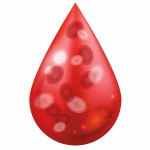A small study has found that adding an additional dose of pegylated interferon to the standard dose of interferon plus ribavirin for the first four weeks of hepatitis C virus (HCV) treatment significantly improved early treatment responses in people coinfected with both HCV and HIV. The study, published in the June 1 issue of AIDS, could offer new hope for coinfected individuals, particularly blacks, who typically have a poorer treatment response.
The HCV treatment options for people coinfected with HIV and HCV are far from ideal. Standard treatment—once-weekly pegylated interferon plus daily ribavirin for 48 weeks—typically achieves a cure in less than 25 percent of coinfected individuals who have the hard-to-treat genotype 1 HCV—and for black individuals with genotype 1, that rate is cut in half again. Though newer HCV treatments have great promise to increase those rates somewhat, the treatments are at least a few years away for coinfected people and it is unlikely that the response rates will be as good as they are for people who are infected with only HCV. Thus, other ways to improve the likelihood of treatment success are needed.
One such strategy would be to increase the regimen’s potency in some way for the first several weeks of treatment, as week 4 and week 12 treatment responses are highly predictive of achieving an eventual cure. That’s what Alison Murphy, MD, from the National Institutes of Health (NIH) in Bethesda, Maryland, and her colleagues set out to explore.
Murphy’s team compared adding an additional dose of pegylated interferon (making it twice weekly) for the first four weeks of treatment with staying on the once-weekly standard dose. The pegylated interferon in both cases was paired with ribavirin, with the dose of that drug determined by a person’s weight. The study included 19 people coinfected with HIV and HCV genotype 1. Ten people received standard therapy, and nine received the additional four doses of pegylated interferon.
The study participants were mostly male, and 58 percent were African American. The average CD4 count was roughly 540 for both groups, and the average HCV viral load was 5.8 logs.
Murphy and her colleagues found that the additional pegylated interferon significantly improved a person’s chances of having an early treatment response. Additional pegylated interferon increased the chances of achieving a rapid virological response (RVR)—which is defined as undetectable HCV levels after four weeks of treatment—from about 30 percent to more than 60 percent. Likewise, early virological response (EVR) rates—which means achieving at least a 2 log drop in HCV after 12 weeks of treatment—increased from just over 40 percent to just over 60 percent.
Cure rates, also called a sustained virological response (SVR)—and which are classified as individuals who have undetectable HCV levels for at least six months following the end of treatment—were also somewhat higher in those who received the additional pegylated interferon. However, the study was not large enough to determine whether this difference was statistically significant.
Of note, the additional interferon did not appear to increase the side effects in most people, though only a larger study could determine whether this is a true result. Also, black participants in this study appeared to do as well as white participants.
“The results of this pilot study show promise for a more effective therapy, particularly for HIV/HCV genotype-1 coinfected African Americans,” the authors conclude. “Future studies are warranted to validate the clinical utility of using twice-weekly peg-IFN treatment to improve SVR among HCV and HIV coinfected patients.”
Advertisement
Advertisement
Advertisement





Comments
Comments